Type i alveolar cells - Study guides, Class notes & Summaries
Looking for the best study guides, study notes and summaries about Type i alveolar cells? On this page you'll find 1631 study documents about Type i alveolar cells.
Page 4 out of 1.631 results
Sort by
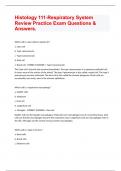
-
Histology 111-Respiratory System Review Practice Exam Questions & Answers.
- Exam (elaborations) • 10 pages • 2024
-
Available in package deal
-
- $11.49
- + learn more
Histology 111-Respiratory System Review Practice Exam Questions & Answers. Which cell is a also called a septal cell? a. Clara cell b. Type I pneumocyte c. Type II pneumocyte d. Dust cell e. Brush cell - CORRECT ANSWER c. Type II pneumocyte The Clara cell is found in the terminal bronchioles. The type I pneumocyte is a squamous epithelial cell. It covers most of the surface of the alveoli. The type II pneumocyte is also called a septal cell. The type II pneumocyte secretes surfactant....
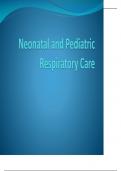
-
Neonatal and Pediatric Respiratory Care Presentation 2024/2025
- Exam (elaborations) • 169 pages • 2024
-
- $18.49
- + learn more
Neonatal and Pediatric Respiratory Care Presentation 2024/2025. Embryonic Development of the Lung A. Placental Gas Exchange: 1. The placenta is an organ that connects the developing fetus to the uterine wall to allow nutrient uptake, waste elimination and gas exchange via the mother’s blood supply. 2. The placenta functions as a feto-maternal organ with two components: the fetal placenta, which develops from the same blastocyst that form the fetus, and the maternal placenta, which de...
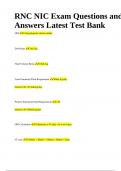
-
RNC NIC Exam Questions and Answers Latest Test Bank.
- Exam (elaborations) • 158 pages • 2023
-
- $14.99
- + learn more
RNC NIC Exam Questions and Answers Latest Test Bank. GIR 6-8mcg/kg/min caloric intake D10 Bolus 2mL/kg Fluid Volume Bolus 10mL/kg Term Parenteral Fluid Requirement 80mL/kg/day Enteral 100-150 mlk/kg/day Preterm Parenteral Fluid Requirement 120 Enteral 150-200ml/kig/day GIR Calculation (%dextrose x IV rate) / (6 x wt in kg) I/T ratio %Metas + Bands / %Metas + Bands + Segs RNC NIC Exam Questions and Answers Latest Test Bank I/T ratio greater than >0.2 to >.25 suggestive of infecti...
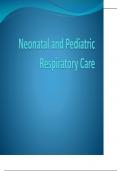
-
Neonatal and Pediatric Respiratory Care Presentation
- Exam (elaborations) • 169 pages • 2024
-
- $18.49
- + learn more
Neonatal and Pediatric Respiratory Care Presentation. Embryonic Development of the Lung A. Placental Gas Exchange: 1. The placenta is an organ that connects the developing fetus to the uterine wall to allow nutrient uptake, waste elimination and gas exchange via the mother’s blood supply. 2. The placenta functions as a feto-maternal organ with two components: the fetal placenta, which develops from the same blastocyst that form the fetus, and the maternal placenta, which develops fro...
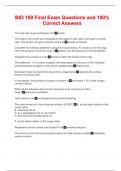
-
BIO 169 Final Exam Questions and 100% Correct Answers
- Exam (elaborations) • 18 pages • 2024
-
Available in package deal
-
- $11.99
- + learn more
The main site of gas exchange is thealveoli The walls of the alveoli are composed of two types of cells, type I and type II alveolar cells. The function of type II alveolar cells is tosecrete surfactant Complete the following statement using the choices below. Air moves out of the lungs when the pressure inside the lungs isgreater than the pressure in the atmosphere Intrapulmonary pressure is thepressure within the alveoli of the lungs The statement, "in a mixture of gases, the total pressu...
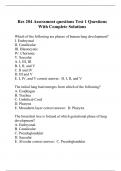
-
Res 204 Assessment questions Test 1 Questions With Complete Solutions.
- Exam (elaborations) • 18 pages • 2023
-
- $12.99
- + learn more
Which of the following are phases of human lung development? I. Embryonal II. Canalicular III. Blastocystic IV. Chorionic V. Saccular A. I, III, III B. I, II, and V C. II and IV D. III and V E. I, IV, and V correct answer: B. I, II, and V The initial lung bud emerges from which of the following? A. Esophagus B. Trachea C. Umbilical Cord D. Pharynx E. Mesoderm layer correct answer: D. Pharynx The bronchial tree is formed at which gestational phase of lung development? A. E...
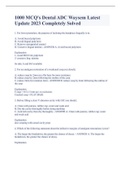
-
1000 MCQ's Dental ADC Waysem Latest Update 2023 Completely Solved
- Exam (elaborations) • 200 pages • 2023
-
- $17.99
- 1x sold
- + learn more
1. For lower premolars, the purpose of inclining the handpiece lingually is to, A. Avoid buccal pulp horn B. Avoid lingual pulp horn C. Remove unsupported enamel D. Conserve lingual dentine - ANSWER A. Avoid buccal pulp horn Explanation 1- avoid BUCCAL pulp horn 2- conserve ling. dentine So take A and B if available 2. For an amalgam restoration of a weakened cusp you should, A. reduce cusp by 2mm on a flat base for more resistance B. reduce cusp by 2mm following the outli...
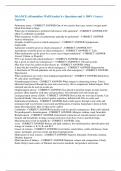
-
DAANCE (all modules) Well Graded A+ Questions and A 100% Correct Answers
- Exam (elaborations) • 13 pages • 2023
-
- $10.99
- 1x sold
- + learn more
Pulmonary artery - CORRECT ANSWER-One of two arteries that carry venous (oxygen poor) blood from heart to lungs What type of intubation is preferred with emesis with aspiration? - CORRECT ANSWER-ETT. LMA or combitube acceptable. What emergency would a cricothyrotomy typically be performed? - CORRECT ANSWER-Airway obstruction Atropine would be given in which emergency? - CORRECT ANSWER-Symptomatic bradycardia Adenosine would be given in which emergency? - CORRECT ANSWER-SVT Amiodarone would ...
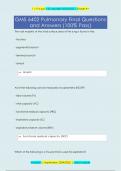
-
GMS6402 Pulmonary Final Questions and Answers (100% Pass)
- Exam (elaborations) • 15 pages • 2024
- Available in package deal
-
- $12.49
- + learn more
What is Atmospheric O2? → 160 mmHg What is Inspired O2? → 150 mmHg What is Alveolar O2? → 100 mmHg What is Arterial O2 (PaO2)? → 100 mmHg What is Arterial CO2 (PaCO2)? → 40 mmHg What is the formula for compliance? 1 | P a g e | © copyright 2024/2025 | Grade A+ Master01 | September, 2024/2025 | Latest update → C = deltaV / deltaP change in lung volume/ change in pressure The vast majority of the total surface area of the lung is found in the → alveoli All of the fo...
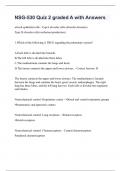
-
NSG-530 Quiz 2 graded A with Answers
- Exam (elaborations) • 16 pages • 2024
-
- $12.99
- + learn more
alveoli epithelial cells - Type I alveolar cells (alveolar structure) Type II alveolar cells (surfactant production) 1.Which of the following is TRUE regarding the pulmonary system? A.Each lobe is divided into bronchi. B.The left lobe is divided into three lobes. C.The mediastinum contains the lungs and heart. D.The larynx connects the upper and lower airways. - Correct Answer: D The larynx connects the upper and lower airways. The mediastinum is located between the lungs and contai...

Study stress? For sellers on Stuvia, these are actually golden times. KA-CHING! Earn from your study resources too and start uploading now. Discover all about earning on Stuvia


